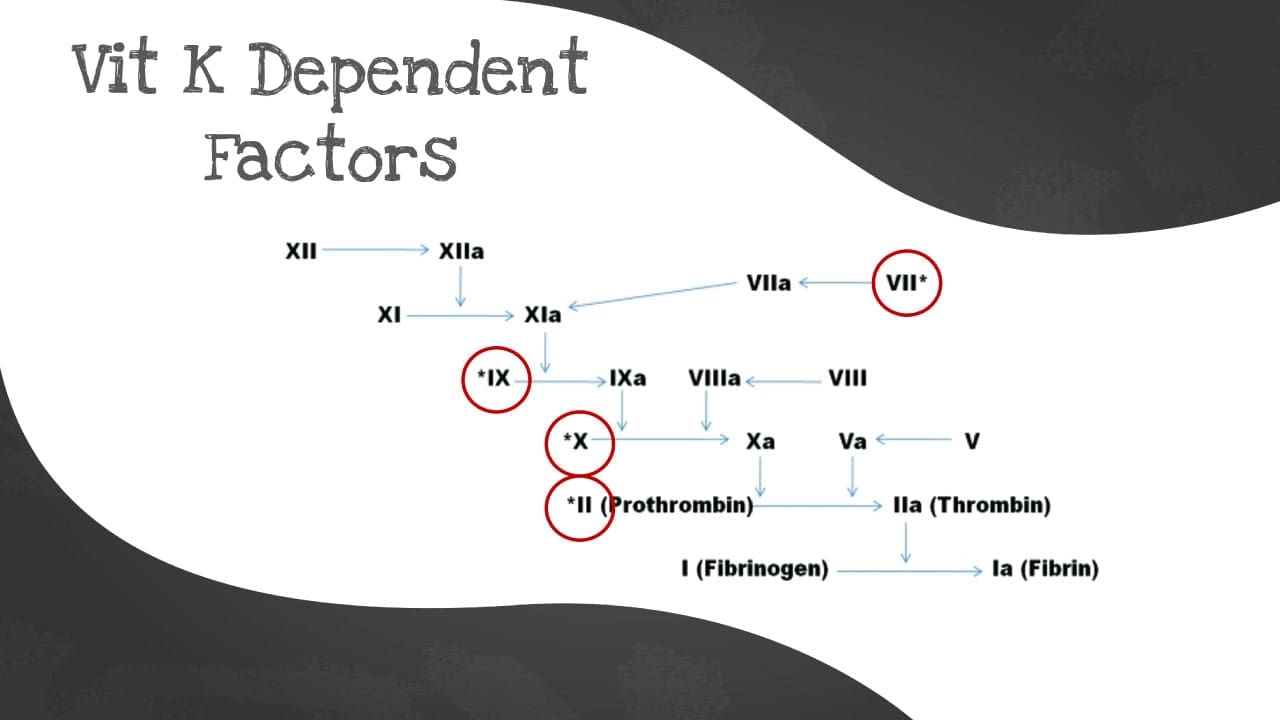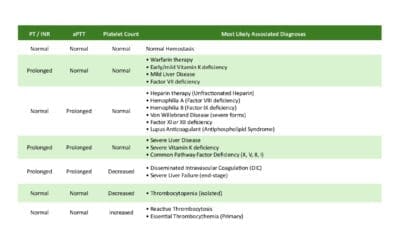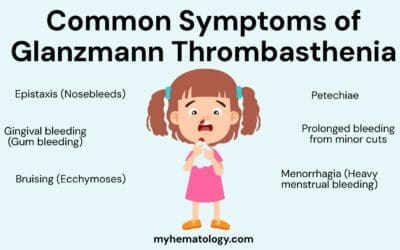TL;DR
Hemorrhagic disease of the newborn is a vitamin K deficiency bleeding disorder that occurs in newborns caused by lack of vitamin K.
Causes
- Liver cell immaturity
- Lack of gut bacterial synthesis
- Low quantities in breastmilk
Laboratory diagnosis ▾
Treatment ▾
- IM prophylaxis
*Click ▾ for more information
What is the hemorrhagic disease of the newborn?
Hemorrhagic disease of the newborn (HDN) is a bleeding disorder that occurs in newborns. It is caused by a deficiency of vitamin K, which is an essential nutrient for blood clotting.
What causes vitamin K deficiency in newborns?
In haemorrhagic disease of the newborn, vitamin K-dependent factors are low at birth and fall further in breast-fed infants in the first few days of life. Newborns are born with low levels of vitamin K because the placenta does not transfer vitamin K well from the mother to the fetus. Vitamin K is also not well absorbed from breast milk. Liver cell immaturity, lack of gut bacterial synthesis of the vitamin and low quantities in breast milk may all contribute to a deficiency which may cause hemorrhage, usually on the 2nd – 4th day of life.
Vitamin K is needed for the production of several clotting factors, including prothrombin and factors VII, IX, and X. These clotting factors are needed for the formation of a blood clot.
Without enough vitamin K, newborns are at risk of bleeding. This bleeding can occur anywhere in the body, but it is most common in the brain and intestines.
The vitamin K cycle
The vitamin K cycle is a complex biochemical process that is essential for blood clotting. It is also involved in bone health and other cellular functions.
The vitamin K cycle can be divided into two main parts: the carboxylation of vitamin K-dependent proteins and the recycling of vitamin K epoxide.

Carboxylation of vitamin K-dependent proteins
Vitamin K is required for the carboxylation of glutamic acid residues in certain proteins, including clotting factors, bone matrix proteins, and other cellular proteins. Carboxylation is the addition of a carboxyl group (COO-) to a molecule.
Vitamin K is converted into hydroquinone by a vitamin K reductase. The hydroquinone is an essential cofactor utilized by the vitamin K-dependent carboxylase to catalyze the oxidative fixation of carbon dioxide to specific glutamic acid residues for example a prothrombin precursor to form a γ-carboxyglutamic acid (Gla) residue e.g. prothrombin. Gla residues are essential for the biological activity of many vitamin K-dependent proteins. Gla residues are also required for the binding of bone matrix proteins to calcium, which is essential for bone health.
The carboxylation of vitamin K-dependent proteins is catalyzed by a group of enzymes called gamma-glutamyl carboxylases (GGCXs). GGCXs require vitamin K, carbon dioxide, and oxygen to function.
During this reaction, vitamin K is converted to an epoxide, which is then converted back to the quinone by a vitamin K epoxide reductase. This vitamin K-dependent post-translational modification takes place in the Golgi apparatus of many cell types and is restricted to specific domains on a small number of vitamin K-dependent proteins.
Vitamin K-dependent γ-carboxylation in hepatocytes is necessary for the biologic activity of a number of coagulation factors, including the zymogens prothrombin, factors VII, IX and X, as well as protein C and S.

Recycling of vitamin K epoxide
When vitamin K is used to carboxylate a protein, it is converted to vitamin K epoxide. Vitamin K epoxide is the inactive form of vitamin K.
Vitamin K epoxide can be recycled back to vitamin K by an enzyme called vitamin K epoxide reductase (VKOR). VKOR requires NADPH, a cofactor, to function.
Once vitamin K is recycled, it can be used to carboxylate another protein.
What happens in vitamin K deficiency?
The vitamin K cycle is important for:
- Blood clotting: Vitamin K is required for the production of several clotting factors, which are essential for blood clotting.
- Bone health: Vitamin K is required for the binding of bone matrix proteins to calcium, which is essential for bone health.
- Other cellular functions: Vitamin K is also involved in other cellular functions, such as cell growth and differentiation.
Vitamin K deficiency can lead to a number of problems, including:
- Bleeding problems: Vitamin K deficiency can lead to bleeding problems, such as easy bruising, nosebleeds, and heavy menstrual periods.
- Bone problems: Vitamin K deficiency can lead to bone problems, such as osteoporosis and fractures.
- Other health problems: Vitamin K deficiency has also been linked to other health problems, such as heart disease and cancer.
Vitamin K can be obtained from food and supplements. Good sources of vitamin K include green leafy vegetables, vegetable oils, and meats.
The recommended daily intake of vitamin K for adults is 120 micrograms for men and 90 micrograms for women. Pregnant and breastfeeding women need more vitamin K, 90 micrograms and 120 micrograms per day, respectively.
Most people can get enough vitamin K from their diet. However, some people may need to take a vitamin K supplement, such as people who are taking certain medications that interfere with the absorption of vitamin K.
How is hemorrhagic disease of the newborn diagnosed?
Hemorrhagic disease of the newborn is diagnosed based on the newborn’s medical history, physical examination, and laboratory tests.
Medical history
The doctor will ask the parents about the newborn’s birth history, including the mother’s diet during pregnancy and any medications she took. The doctor will also ask about the newborn’s family history of bleeding disorders.
Physical examination
The doctor will perform a physical examination of the newborn to look for signs of bleeding, such as bruising, nosebleeds, and bleeding from the umbilical cord. The doctor will also check the newborn’s vital signs, such as heart rate, respiratory rate, and blood pressure.
Laboratory tests
The most important laboratory test for diagnosing hemorrhagic disease of the newborn is the prothrombin time (PT). The PT measures how long it takes for blood to clot. A prolonged PT is a sign of a bleeding disorder, such as hemorrhagic disease of the newborn. However, the platelet count is normal. Both the PT and APTT time are abnormal with normal platelet count and fibrinogen and absence of fibrin degradation products.
Other laboratory tests that may be helpful in diagnosing this disorder include:
- Activated partial thromboplastin time (APTT): This test measures how long it takes for blood to clot in the presence of certain clotting factors. A prolonged APTT may be a sign of a bleeding disorder.
- Vitamin K level: This test measures the amount of vitamin K in the blood. A low vitamin K level may be a sign of hemorrhagic disease of the newborn.
- Fibrinogen count is normal.
- Absence of fibrin degradation products: The presence of FDPs in the blood indicates that fibrin clots are being broken down, which can lead to further bleeding. Therefore, the absence of FDPs in this disorder is a good sign, indicating that the newborn’s blood clotting system is working properly and that the bleeding is likely to stop on its own.
Differential diagnosis
There are a number of other conditions that can cause bleeding in newborns, including:
- Thrombocytopenia: This is a condition in which there is a low platelet count. Platelets are blood cells that help blood clots.
- Disseminated intravascular coagulation (DIC): This is a condition in which blood clots form throughout the body, blocking blood vessels and preventing blood from flowing properly.
- Liver disease: The liver produces several clotting factors. Liver disease can damage the liver and reduce the production of clotting factors.
- Genetic bleeding disorders: There are a number of genetic bleeding disorders that can cause bleeding in newborns, such as hemophilia and von Willebrand disease.
If the newborn has a bleeding disorder that is not caused by HDN, the doctor will recommend additional tests and treatment to manage the disorder.
How do we treat hemorrhagic disease of the newborn?
Treatment
The treatment for HDN is a single injection of vitamin K. The injection is usually given to the newborn within a few hours of birth.
In some cases, newborns with HDN may need to be given additional injections of vitamin K, or they may need to be given blood transfusions.
Prevention
HDN can be prevented by giving all newborns a single injection of vitamin K shortly after birth. The injection is safe and effective.
Frequently Asked Questions (FAQs)
What causes bleeding in a newborn?
The most common cause of bleeding in a newborn is vitamin K deficiency.
Newborns have limited vitamin K reserves at birth, and their gut bacteria, which produce vitamin K, are not yet fully developed. Without enough vitamin K, blood clotting can be impaired, leading to bleeding.
Other less common causes of bleeding in newborns include:
- Birth trauma: Injuries sustained during delivery can cause bleeding.
- Inherited clotting disorders: Some babies are born with inherited conditions that affect blood clotting.
- Platelet disorders: Problems with platelets, which help blood clot, can also cause bleeding.
- Infections: Certain infections can lead to bleeding.
- Liver disease: Liver problems can interfere with blood clotting.
Do breastfed babies need vitamin K?
Yes, breastfed babies need vitamin K. While breast milk is packed with nutrients, it doesn’t contain enough vitamin K to meet a newborn’s needs. Vitamin K is essential for blood clotting and preventing hemorrhagic disease of the newborn.
Why does vitamin K deficiency have normal bleeding time?
Vitamin K deficiency can have a normal bleeding time. This is because the bleeding time test primarily measures the function of platelets, which are not directly affected by lack of vitamin K.
What food is highest in vitamin K?
Leafy green vegetables are generally the best source of vitamin K. Some of the highest vitamin K foods include:
- Kale
- Spinach
- Collard greens
- Swiss chard
- Turnip greens
- Mustard greens
- Broccoli
- Brussels sprouts
Other good sources of vitamin K include:
- Natto (a fermented soybean product)
- Sauerkraut
- Liver
- Eggs
- Avocado
- Kiwi
- Raspberries
It’s important to note that cooking can reduce the vitamin K content of some foods, so it’s best to consume them raw or lightly cooked whenever possible.
How to tell if you are vitamin K deficient?
Unfortunately, there are no specific symptoms of vitamin K deficiency that are easily recognizable. Often, the first sign is excessive bleeding or bruising.
However, if you have any of the following risk factors for vitamin K deficiency, you may be more susceptible:
- Newborn: Newborns have limited vitamin K reserves and may be at risk of deficiency.
- Malabsorption: Conditions that interfere with the absorption of nutrients from the intestines, such as celiac disease or Crohn’s disease, can lead to vitamin K deficiency.
- Liver disease: The liver plays a role in the activation of vitamin K. Liver damage can impair this process and lead to deficiency.
- Certain medications: Some medications, such as blood thinners and antibiotics, can interfere with vitamin K absorption or function.
- Intestinal surgery: Surgery that affects the small intestine can disrupt vitamin K absorption.
Who is likely to have vitamin K deficiency?
Certain individuals are more likely to have vitamin K deficiency than others. These include:
- Newborns: As mentioned earlier, newborns have limited vitamin K reserves and may be at risk of deficiency.
- People with malabsorption conditions: Conditions that interfere with the absorption of nutrients from the intestines, such as celiac disease or Crohn’s disease, can lead to vitamin K deficiency.
- Individuals with liver disease: The liver plays a role in the activation of vitamin K. Liver damage can impair this process and lead to deficiency.
- People taking certain medications: Some medications, such as blood thinners and antibiotics, can interfere with vitamin K absorption or function.
- Individuals who have undergone intestinal surgery: Surgery that affects the small intestine can disrupt vitamin K absorption.
- Individuals with certain dietary restrictions: People who follow a strict vegan or vegetarian diet if they do not consume enough vitamin K-rich foods or supplements.
Disclaimer: This article is intended for informational purposes only and is specifically targeted towards medical students. It is not intended to be a substitute for informed professional medical advice, diagnosis, or treatment. While the information presented here is derived from credible medical sources and is believed to be accurate and up-to-date, it is not guaranteed to be complete or error-free. See additional information.
References
- Kher P, Verma RP. Hemorrhagic Disease of Newborn. 2023 Jun 26. In: StatPearls [Internet]. Treasure Island (FL): StatPearls Publishing; 2023 Jan–. PMID: 32644420.
- Ng E, Loewy AD. Guidelines for vitamin K prophylaxis in newborns. Paediatr Child Health 2018, 23(6):394–397.
- Goldberg S, Hoffman J. Clinical Hematology Made Ridiculously Simple, 1st Edition: An Incredibly Easy Way to Learn for Medical, Nursing, PA Students, and General Practitioners (MedMaster Medical Books). 2021.
- Keohane EM, Otto CN, Walenga JM. Rodak’s Hematology 6th Edition (Saunders). 2019.
- Hoffman R, Benz EJ, Silberstein LE, Heslop H,Weitz J, Anastasi J. Hematology: Diagnosis and Treatment E-Book (Hematology Basic Principles and Practice) 6th Edition (Churchill Livingstone). 2013.



